by Aleisha Amohia, Koha Technical Lead
The Koha library software project now has a built-in CMS (content management system) feature which allows libraries to create their own content pages and add them to their online public catalogue (OPAC). This is perfect for those libraries that need a few more web pages to provide information to their members in one place, and don’t want to maintain another website.
The Catalyst Koha team was proud to develop this feature, now available in Koha 22.11, with sponsorship from Region Halland in Sweden, Chartered Accountants Australia and New Zealand, and Horowhenua Libraries.
Tools for custom content
In Koha 22.11 there are a number of tools available for generating custom content for the OPAC. They can be found on the Tools page in the staff interface, under the ‘Additional tools’ heading. These tools all serve different purposes. Take a look at our ‘Customising your Koha catalogue blog post which describes how to use the News and HTML customizations tools. This tutorial will describe how to use the Pages tool.
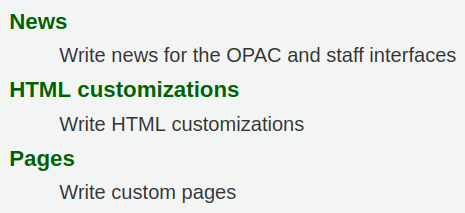
Add a new page
The Pages tool provides the ability to develop custom pages using a WYSIWYG (what you see is what you get) editor or a text editor. The WYSIWYG editor comes with the functions of word processor, which means there are buttons available to easily format content with fonts and colours, or include headings, lists, hyperlinks, images and tables. For those more comfortable writing source code, the text editor provides the option to develop custom content in HTML.
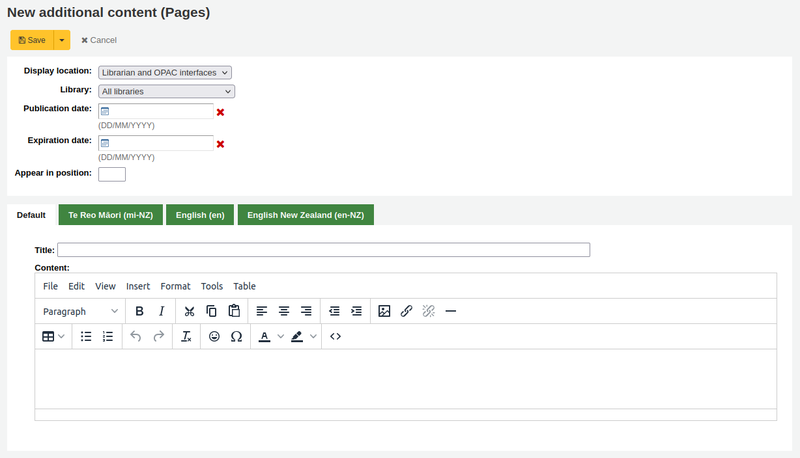
There are a few options available to configure when creating a new page:
- Display location – choose whether the page should be accessible on the staff interface, the OPAC, or both
- Library – choose whether the page should be accessible for patrons at a specific library, or all libraries
- Publication date – choose when the page should be published and visible. This can be set to a date in the past, or a date in the future to ‘schedule’ the publication of the page
- Expiration date – choose when the page should be expired and hidden. This can be used to hide a page when it is no longer needed, and can be set to a date in the future
Once the key settings for a page are configured, it’s time to start building the custom content. For Koha libraries providing their OPAC translated for other languages, custom content can be built in each of those installed languages too.
The content should be built into the Default language tab first, then translated content built into the other language tabs. The default language is used first if Koha has no preferred language information about the patron, but it is also used as a fallback, if there is no custom content developed for the page in the language the patron is using.
Use a custom page
Once the page has been developed and saved, you will see a summary table of all custom pages. This table also displays the generated links to access these custom pages. The links will be available in both the default language, and the installed language currently in use by the logged in staff member.
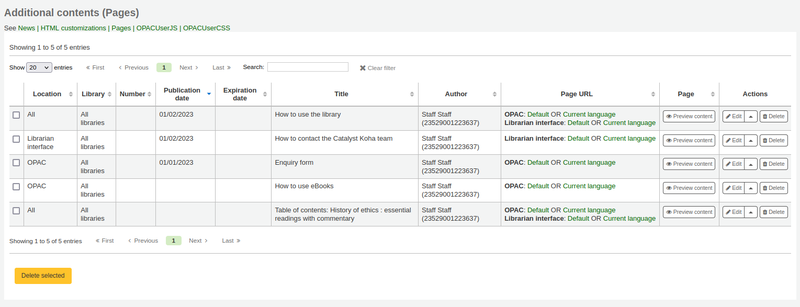
There is a button to preview the created page. This is helpful to check how the page looks and functions before it is deployed.
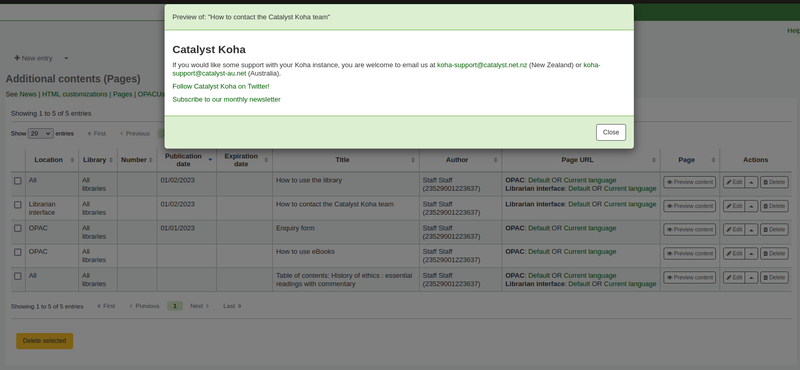
Now the page has been created, there are a number of ways to make the page accessible to your patrons in the Koha OPAC.
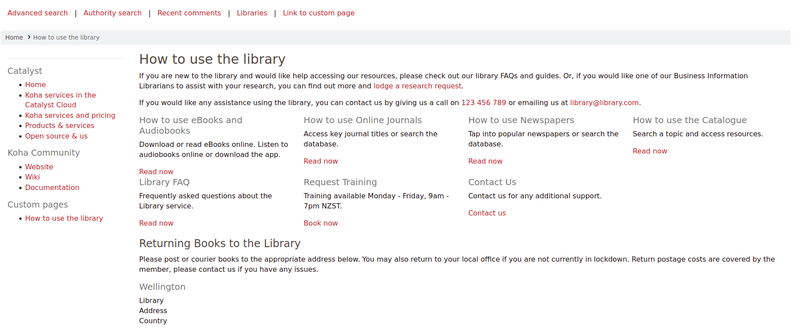
One option is to use an HTML customisation to add the link to the page to a section of the OPAC. The page can be added as a navigation link (in OpacNav, OpacNavBottom, or OpacNavRight). Depending on the page, it may be more suitable in the header (opacheader), footer (opaccredits), or main section of the homepage (OpacMainUserBlock).
HTML customisations are only displayed on the OPAC, so News items would be the appropriate tool to add the link to the main landing page of the staff interface.
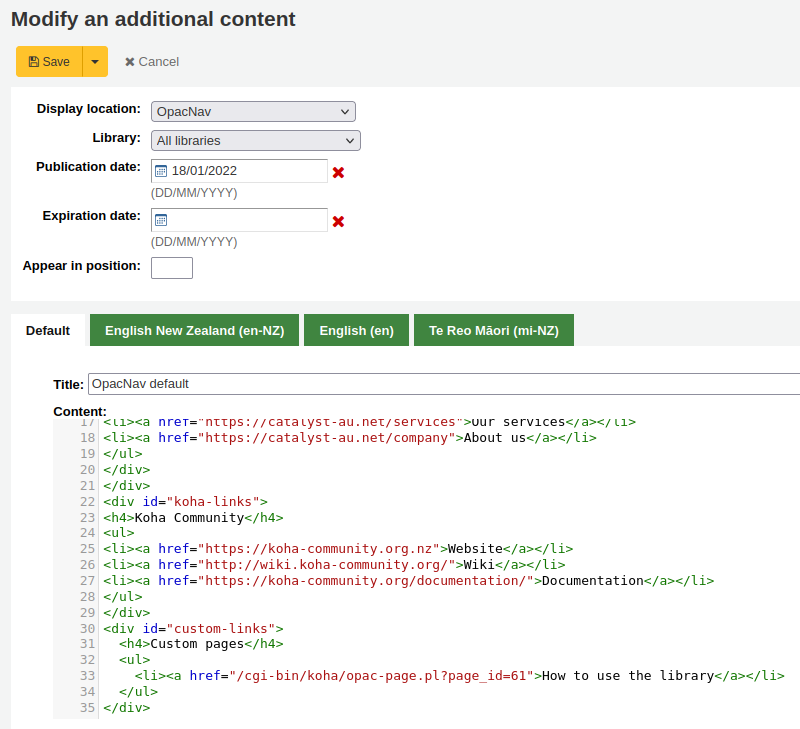
The benefit of putting the page link in an HTML customisation or News item is that you can use the WYSIWYG editor, instead of writing code. However, there is always the option to write the content in the HTML text editor too, if you prefer.
Those more proficient in writing code could use jQuery (Javascript) to insert their page link anywhere in the OPAC or staff interface.

Using jQuery, the pages could be added to either interface as simple text links, or as more advanced button links or image links. Add code to the OPACUserJS system preference to apply jQuery to the OPAC, or to the IntranetUserJS system preference to apply jQuery to the staff interface.
Clever ways to use custom pages
There are many interesting ways to use custom pages in a Koha library. We’ve heard discussion of pages being used for tables of contents, frequently asked questions pages for the library, and enquiry forms.
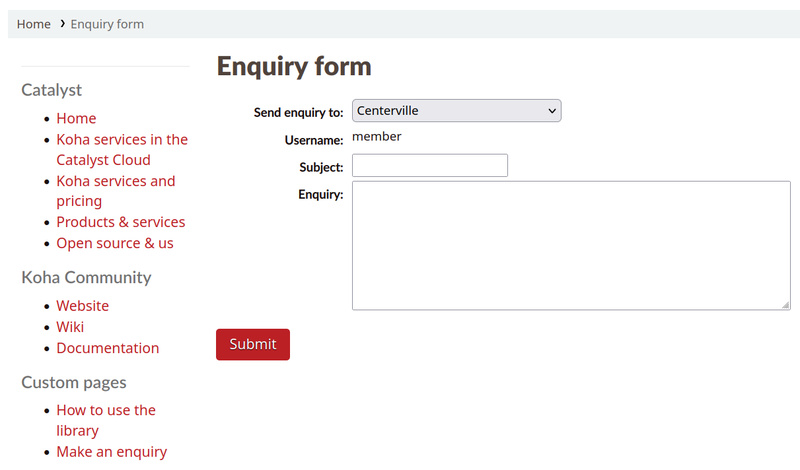
Another way to make custom Koha page content accessible for users, would be to catalogue those pages so they pop in in Koha search results, for example library tutorials that patrons may be looking for.
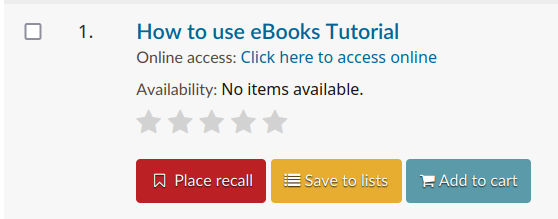
Once the page has been created, it can be catalogued in the URI field of a record (856$u). Alternatively, it could be catalogued in the URI field of an item attached to a record (952$u). Both of these fields get converted into hyperlinks by Koha. If catalogued in a record or item, it would then be indexed and become searchable.
Once catalogued, these pages could be used in other ways that are typically reserved for books and other records. The records representing pages can be added to lists, or stored in virtual collections or locations that make them easier to find in the catalogue. They could even be captured and displayed in carousels!
We’d love to hear about how you would like to use the Koha CMS feature in your library, and if there are any improvements or enhancements we could investigate together.
Catalyst Koha
If you have any questions or comments about this News item, or would like some support with your Koha instance, you are welcome to email us at [email protected] (New Zealand) or [email protected] (Australia).
Follow Catalyst Koha on Twitter or sign up to our newsletter!